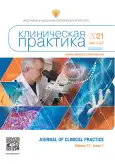Ipsilateral block or can a single ECGbe used for the diagnosis?
- Authors: Konev A.V.1, Simonenko E.V.1, Khimiy O.V.1, Korolev S.V.1, Dundua D.P.1
-
Affiliations:
- Federal Scientific and Clinical Center for Specialized Medical Assistance and Medical Technologies of the Federal Medical Biological Agency
- Issue: Vol 12, No 1 (2021)
- Pages: 104-112
- Section: Case reports
- URL: https://journals.rcsi.science/clinpractice/article/view/65078
- DOI: https://doi.org/10.17816/clinpract65078
- ID: 65078
Cite item
Abstract
Background: Pre-excitation syndrome (premature excitation of the ventricles) is a congenital anomaly in the structure of the cardiac conduction system and consists in the presence of an additional atrioventricular connection. The possibility to assume the presence of pre-excitation syndrome accompanied by tachycardia based on an electrocardiogram provides a clue to the correct diagnosis and subsequent treatment of the patient. Clinical case description: A clinical case of a 56-year-old patient is presented, who was admitted to the FRCC of the FMBA of Russia in January, 2021 with paroxysms of previously undiagnosed tachycardia. During Holter monitoring, an episode of heart palpitations was recorded. When analyzing an ECG fragment, it was possible, by calculating the tachycardia cycle length, to suspect the presence of a latent ventricular pre-excitation syndrome, which was accompanied by the development of orthodromic atrioventricular reciprocal tachycardia with a bundle branch block on the side of the additional atrioventricular connection (ipsilateral block). The patient underwent endocardial electrophysiological examination to confirm the presence of the bundle, followed by the catheter treatment of the atrioventricular connection. A good postoperative clinical result was obtained. Conclusion: It is important to be able to make a differential diagnosis between the presence of a latent pre-excitation syndrome with the development of orthodromic atrioventricular reciprocal tachycardia with the bundle branch block on the side of the extra atrioventricular junction (ipsilateral block) and other supraventricular tachycardias with an aberration along one of the bundle branches, in order to determine the tactics of the patient management and to control the effectiveness of the treatment.
Full Text
##article.viewOnOriginalSite##About the authors
Aleksey V. Konev
Federal Scientific and Clinical Center for Specialized Medical Assistance and Medical Technologies of the Federal Medical Biological Agency
Author for correspondence.
Email: konevalexv@mail.ru
ORCID iD: 0000-0002-1762-6822
SPIN-code: 7559-8450
Cand. Sci. (Med.)
Russian Federation, 28 Orekhovy Boulevard street, 115682 MoscowEvgeniya V. Simonenko
Federal Scientific and Clinical Center for Specialized Medical Assistance and Medical Technologies of the Federal Medical Biological Agency
Email: evgeniya12089@gmail.com
ORCID iD: 0000-0003-2526-0741
MD
Russian Federation, 28 Orekhovy Boulevard street, 115682 MoscowOrysya V. Khimiy
Federal Scientific and Clinical Center for Specialized Medical Assistance and Medical Technologies of the Federal Medical Biological Agency
Email: Orysya_himii@mail.ru
ORCID iD: 0000-0002-8828-9384
SPIN-code: 8007-1319
MD
Russian Federation, 28 Orekhovy Boulevard street, 115682 MoscowSergey V. Korolev
Federal Scientific and Clinical Center for Specialized Medical Assistance and Medical Technologies of the Federal Medical Biological Agency
Email: sergejkorolev@yandex.ru
ORCID iD: 0000-0001-5513-2332
SPIN-code: 4545-3450
Cand. Sci. (Med.)
Russian Federation, 28 Orekhovy Boulevard street, 115682 MoscowDavid P. Dundua
Federal Scientific and Clinical Center for Specialized Medical Assistance and Medical Technologies of the Federal Medical Biological Agency
Email: david.doundoua@gmail.com
ORCID iD: 0000-0001-7345-0385
Doct. Sci. (Med.), Professor
Russian Federation, 28 Orekhovy Boulevard street, 115682 MoscowReferences
- Ардашев A.B. Синдром Вольфа-Паркинсона-Уайта: клиника, диагностика, лечение. Москва: Медпрактика-М, 2014. С. 16–30. [Ardashev AB. Wolf-Parkinson-White syndrome: clinic, diagnosis, treatment. Moscow: Medpraktika-M; 2014. Р. 16–30. (In Russ).]
- Ардашев В.Н., Ардашев A.B., Стеклов В.И. Лечение нарушений сердечного ритма. Москва: Медпрактика-М, 2005. С. 223–227. [Ardashev VN, Ardashev AB, Steklov VI. Treatment of cardiac arrhythmias. Moscow: Medpraktika-M; 2005. Р. 223–227. (In Russ).]
- Ревишвили А.Ш., Давтян К.В., Лабарткава Е.З. Особенности электрофизиологической диагностики при синдроме предвозбуждения: множественные дополнительные предсердно-желудочковые соединения // Вестник аритмологии. 2008. № 51. С. 61–68. [Revishvili ASh, Davtyan KV, Labartkava EZ. Features of electrophysiological diagnostics in preexcitation syndrome: multiple additional atrioventricular connections. Bulletin of Arrhythmology. 2008;(51):61–68. (In Russ).]
- Benson DW, Cohen MI. Wolff-Parkinson-White syndrome: lessons learnt and lessons remaining. Cardiol Young. 2017;27(S1):S62–S67.
- Бокерия О.Л., Ахобеков А.А. Синдром Вольфа-Паркинсона-Уайта // Анналы аритмологии. 2015. Т. 12, № 1. С. 25–37. [Bockeria OL, Akhobekov AA. Wolff-Parkinson-White syndrome. Annaly aritmologii. 2015;12(1):25–37. (In Russ).] doi: 10.15275/annaritmol.2015.1.4
- Ардашев А.В., Рыбаченко М.С. Эффективность лечения больных синдромом Вольфа–Паркинсона–Уайта методом радиочастотной катетерной абляции дополнительного атриовентрикулярного соединения // Военно-медицинский журнал. 2007. Т. 328, № 6. С. 73–74. [Ardashev AV, Rybachenko MS. Effectiveness of treatment of patients with Wolf syndrome-Parkinson’s disease-White’s method of radiofrequency catheter ablation of an additional atrioventricular junction. Military Medical journal. 2007;328(6):73–74. (In Russ).]
- Bhatia A, Sra J, Akhtar M. Preexcitation Syndromes. Curr Probl Cardiol. 2016;41(3):99–137.
- Kesler K, Lahham S. Tachyarrhythmia in Wolff-Parkinson-White Syndrome. West J Emerg Med. 2016;17(4):469–470.
Supplementary files











